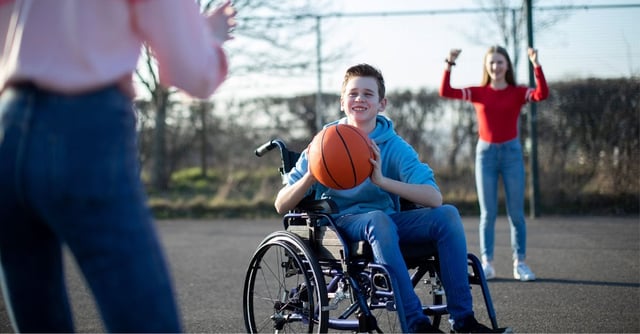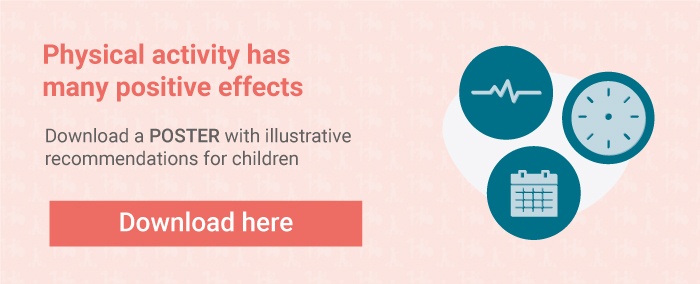
Jul 27, 2023What exercise equipment is available for people with CP?

Back to Blog Overview
Children, adolescents and adults with Cerebral Palsy (CP) are less physically active than their peers without disability. The more severe the disability, the lower participation in physical activity. Adapted equipment can enhance physical activity, participation and quality of life.
In this article you can read about:
- Cerebral palsy and physical activity
- What are the physical activity recommendations for people with CP?
- What type of adaptive equipment is available for physical activity and leisure activities?
- Adapted bikes
- Frame running
- Dynamic standing
- Disability football
- Swimming
- Boccia
- Wheelchair Basketball
Cerebral palsy and physical activity
Children, adolescents and adults with CP are less physical active in comparison with people without a disability. Research has also found that level of physical activity is closely related to level of disability. The more severe the level of motor function disability, measured with the Gross Motor Function Classification system (GMFCS), the less physically active the person is. Studies also highlight that people with less severe motor disability participate in more varied forms of physical activity, while people who are more severely affected mainly participate in swimming and horse riding.
Positive overall health benefits of physical activity are the same for people with or without a disability, so therefore it is important to encourage and make physical activity accessible for people with reduced motor function.
What are the physical activity recommendations?
In 2020 the World Health Organization (WHO) published new guidelines on physical activity and sedentary behaviour. These guidelines also included recommendations for people with disabilities. WHO suggests that physical activity can be incorporated into the lives of children, adolescents, and adults with disabilities through recreational and leisure activities (play, games, sports, or planned exercises), physical education, transportation (wheeling, walking, and cycling), or even household chores. Activities can take place at home, school, work, or within the community. It is important that individuals with disabilities are given equal opportunities and encouragement to engage in physical activities suitable for their age and abilities. These activities should be enjoyable and diverse, offering a range of options to cater to individual preferences.
The recommendations are divided into two age groups:
Aged 5-17 years
It is recommended that children and adolescents should do at least 60 minutes per day of moderate to vigorous intensity activity. This activity should mainly contain aerobic physical activity.
In addition, at least 3 days a week, vigorous intensity aerobic activities should be done, as well as those that strengthen muscles and bone.
The recommendations also emphasise the importance of reducing sedentary behaviour by sitting less and moving more! Doing some physical activity is better than doing none.

Aged 18 years and older
It is recommended that people aged 18 years and older should do at least 150-300 minutes of moderate-intensity aerobic physical activity weekly OR 75-150 minutes with vigorous-intensity aerobic physical activity weekly.
In addition, muscle strengthening activities at a moderate to vigorous intensity should be done at least twice a week.
It is generally recommended to reduce sedentary time by replacing it with physical activity of any intensity and remember that doing some physical activity is better than doing none.

It is generally recommended to reduce sedentary time by replacing it with physical activity of any intensity and remember that doing some physical activity is better than doing none.
What type of adaptive equipment is available for physical activity and leisure activities?
There are several types of adaptive equipment available for people with disabilities to facilitate physical activity. Nevertheless, what is accessible and reimbursed in your country may vary.
Below follows a list of suitable activities and equipment. The list is not exhaustive, but may inspire you to look further into what fits you or your child.
Adapted bikes
There are several types of bikes available specially designed for people with disabilities. Riding a bike is an excellent activity and it can be used both as a leisure activity, but also as transportation. Many bikes for people with disabilities have three wheels. This to make the bike more stable and enable independency. Here are some variations you often need to decide on:
- Pedalling
- Handcycling
- Tandem
- Upright on a saddle
- Semi-recumbent on a supported seat
- Gears
- Braking system
- Electric assist
- Carer steering handle
It is recommended to seek support from your therapist when deciding upon a bike or trike, as there are so many choices to make. A properly fitted and correctly equipped bike, suited to the needs of the rider can make a huge difference in experiencing the joy of cycling.
Frame running
Frame running is an adapted sport for people with a disability who cannot functionally run. It is a type of bike, but without pedals. It consists of a three wheeled frame, and the user is supported by saddle and body plate. The runners uses their feet to push themself forward over the ground. Frame Running is a recreation activity and is a great way to improve overall fitness and it is also an athletic discipline. You can find more information about Frame running in England here: https://cpsport.org/frame-running/
Dynamic standing – Innowalk
Children, adolescents and adults with a severe disability often have limited opportunities to be physically active and it can be a challenge to participate in sports or other outdoor activities. Nevertheless, physical activity is still important. The Innowalk is a motorised movement device for home-use that encourages not just standing, but standing and moving simultaneously, so-called ‘dynamic standing’. It can in a way be described as a “cross-trainer”, but with enough supporting points to enable movement in standing to severely disabled people who are unable to stand and walk on their own. It allows guided, repetitive movement in an upright position with natural weight-bearing and thus gives a unique opportunity to take part in physical activity.

Disability football
Football is a fun and engaging activity and often loved by children and adults alike. In England alone, there are over 40,000 registered football clubs, almost twice as many as Brazil! With a little adaptation of this game, children and adults with physical and learning disabilities can participate. England Football have an ambitious plan to develop disability football, and their webpage covers a wide range of resources and information on ways football can be adapted to be fully inclusive for all. ‘Football Your Way’ is The Football Association’s (FA) Game plan for Disability Football 2021-24. The plan is the first of its kind and covers seven key areas, demonstrating the FA’s commitment to ensuring disabled people can engage and participate in football their way, from grassroots all the way to the elite end of the game
Swimming
Activity in the pool is a fun activity and suits all ages. The buoyancy from the water enables people to move freely in the water with little effort. Often the warm water also reduces spasticity and pain.
It is an activity that can be adapted in a wide variety of ways for many types of disabilities. Many therapists offer hydrotherapy, but it is also an activity that is fun to do together with family and friends.
Wheelchair Basketball
Wheelchair basketball is a fast-paced and fast-growing sport that allows non-disabled and disabled people to compete together in its domestic leagues and competition. There are currently 17,000 people playing the sport in the UK, 200+ teams, and a potential participation growth of up to 70,000. 21% of all national league players are non-disabled, making it an extremely inclusive sport. It is a sport of skill and physicality on the court and provides competitors with the tools to become more resilient and independent in their everyday lives. British Wheelchair Basketball is the governing body for wheelchair basketball in the United Kingdom. Visit their webpage to find out more https://britishwheelchairbasketball.co.uk/
Boccia
Boccia (pronounced bot-cha), is a paralympic sport designed for athletes with high support needs and has no Olympic equivalent. It is a target sport played indoors with soft leather balls. Athletes throw, kick or use a ramp to propel a ball onto the court with the aim of getting closest to a 'jack' ball, and is played indoors on a court similar in size to a badminton court. Find out more about boccia in the UK here - http://boccia.uk.com/
These were just a few examples of adapted activities. If you or your child would like to test a new activity or specially adapted equipment, I recommend contacting your local sports club or special needs organization, who can help you find a fun activity close to where you live.
Stay active and have fun!
References
- The coolest I know – a qualitative study exploring the participation experiences of children with disabilities in an adapted physical activities program https://www.bhss.no/media/3484/steinhart_et_al_perceived-facilitators-and-barriers-for-participation.pdf
- Physical activity in a total population of children and adolescents with cerebral palsy https://www.sciencedirect.com/science/article/abs/pii/S0891422212001710?via%3Dihub
- What influences participation in leisure activities of children and youth with physical disabilities? A systematic review
- https://www.sciencedirect.com/science/article/abs/pii/S0891422211000461?via%3Dihub
- Exercise and physical activity recommendations for people with cerebral palsy https://onlinelibrary.wiley.com/doi/full/10.1111/dmcn.13053

Rikke Damkjær Moen brings many years of experience as clinical physiotherapist to the Made for Movement team. Her mission is to ensure that everybody, regardless of mobility problems, should be able to experience the joy and health benefits of physical activity. As our Medical Manager, Rikke is passionate about sharing knowledge so that individuals with special needs, families, and clinicians can discover the possibilities and solutions provided by Made for Movement.


